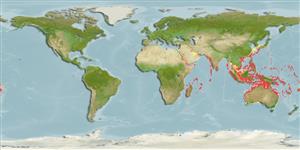Issue
Apogonichthyoides enigmaticus is considered valid in Ref. 88147:68.
Environment: milieu / climate zone / depth range / distribution range
Ecología
marino asociado a arrecife; rango de profundidad 3 - 60 m (Ref. 30874), usually 10 - 34 m (Ref. 37816). Tropical
Indo-West Pacific: Red Sea (Ref. 84159), East Africa to the Philippines (Ref. 559), north to Miyakejima, Japan (Ref. 559) and Taiwan (Ref. 9147), south to northern Australia (Ref. 2334) and Society Islands (Ref. 76833).
Tamaño / Peso / Age
Maturity: Lm ? range ? - ? cm
Max length : 10.0 cm TL macho / no sexado; (Ref. 559); common length : 8.0 cm SL macho / no sexado; (Ref. 37816)
Espinas dorsales (total): 8; Radios blandos dorsales (total): 9; Espinas anales 2; Radios blandos anales: 8. Reddish dorsally, yellowish ventrally. Body depth lower than A. aureus and no wide black band on caudal peduncle (Ref. 559). Juveniles pale with short blue lines on snout (Ref. 48635). Adults to deep golden with blue spots in three rows on mid-lateral surface of body (Ref. 93839).
Inhabits rocky cliffs. Also in sheltered coastal to outer reefs from shallow flats to over 50 m depth. Usually in pairs, small aggregations, or occasionally schooling (Ref. 48635). Occurrence is rather rare (Ref. 559). Feeds on zooplankons and invertebrates (Ref. 89972). Minimum depth reported taken from Ref. 9710.
Life cycle and mating behavior
Madurez | Reproducción | Puesta | Huevos | Fecundidad | Larva
Mouthbrooders (Ref. 240). Distinct pairing during courtship and spawning (Ref. 205).
Gon, O., 1986. Apogonidae. p. 546-561. In M.M. Smith and P.C. Heemstra (eds.) Smiths' sea fishes. Springer-Verlag, Berlin. (Ref. 4329)
IUCN Red List Status (Ref. 130435)
Threat to humans
Harmless
Human uses
Más información
ReferenciasAcuiculturaPerfil de acuiculturaRazasGenéticaElectrophoresesheritabilidadEnfermedadesProcesamientoNutrientsMass conversion
ColaboradoresImágenesStamps, Coins Misc.SonidosCiguateraVelocidadTipo de nataciónSuperficie branquialOtolitosCerebrosVisión
Herramientas
Special reports
Download XML
Fuentes de Internet
Estimates based on models
Preferred temperature (Ref.
123201): 24.5 - 29.1, mean 27.5 °C (based on 694 cells).
Phylogenetic diversity index (Ref.
82804): PD
50 = 0.5000 [Uniqueness, from 0.5 = low to 2.0 = high].
Bayesian length-weight: a=0.00501 (0.00201 - 0.01253), b=3.26 (3.04 - 3.48), in cm total length, based on LWR estimates for this (Sub)family-body shape (Ref.
93245).
Nivel trófico (Ref.
69278): 3.5 ±0.50 se; based on food items.
Resiliencia (Ref.
120179): Alto, población duplicada en un tiempo mínimo inferior a 15 meses (Preliminary K or Fecundity.).
Fishing Vulnerability (Ref.
59153): Low vulnerability (10 of 100).
Nutrients (Ref.
124155): Calcium = 163 [86, 279] mg/100g; Iron = 0.975 [0.559, 1.649] mg/100g; Protein = 18.5 [17.4, 19.6] %; Omega3 = 0.112 [0.062, 0.209] g/100g; Selenium = 38.6 [17.7, 84.3] μg/100g; VitaminA = 81.8 [26.0, 250.9] μg/100g; Zinc = 2.05 [1.32, 3.00] mg/100g (wet weight);
